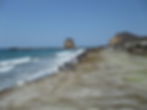
Ecuador and Galapagos

Get acquainted with our beautiful country
This is our beautiful Ecuador, a country blessed by the sun and the one we'd like to share with you. Ecuador is one of seventeen megadiverse countries in the world according to Conservation International, and it has the most biodiversity per square kilometer of any nation in the planet.

Machalilla
National
Park

Machalilla National Park
This interesting and rich national park is located in continental Ecuador, in the coastal province of Manabi between the towns of Puerto López and Jipijapa. It has an extension of 55,000 hectares and includes Isla de la Plata and Salango, besides other islets, rocks, cliffs, bays and beaches; these, together with its beautiful views and untouched areas constitute the major attraction of the park.
The most important beaches are Los Frailes, Salaite, La Playita, Los Balsamos, La Tortuguita, etc. Among the islets and rocks, we have Pedernales, La Viuda, Sucre, Horno de Pan, Punta Mala, etc.and Albatross.

Puerto
López

Puerto López
Puerto López, a fisherman's village within the Machalilla Natural Park, is the starting point of tourist operations in the area. Here begins the unique adventure of observing the marine-land ecosystem offered by the pacific coast of Ecuador.

Isla de la Plata

Isla de la Plata
Isla de la Plata has an extension of 12km² and a maximum of 167 meters above sea level and is located 22 nautical miles to the northwest of Puerto López. Its main features are rocky cliffs, beaches, bays, and rocks. The land area features the only primary tropical dry forest along the Ecuadorian coast, with an important transition towards the tropical humid forest in the San Sebastian area. The land area counts with many archaeological sites, due to settlements during the Ecuadorian prehistoric era, starting from the Machalilla to the Manteño-Huancavilca cultures.
The abundant vegetation of the land area includes species such as Algarrobo, Palo Santo, Ceibo (Kapok), Muyuyo, Tuna, Barbasco, Fernán Sánchez, Matapalo, Guayacan, Balsa, Laurel, among others. Isla de la Plata has flora similar to that of the continent. The great fauna biodiversity from the coast to the highest part of the island includes deer, guantas, guatusas (a kind of agouti), howler monkeys, squirrels, ant bears, land iguanas, snakes, parakeets, umbrella birds, parrots, sparrows, swallows, cocubes, humming birds, land pigeons, sparrow hawks, pelicans, etc.
The land area is considered one of the most important sites for bird watching in the world. Isla de la Plata is important for eco-tourism as it counts with marine birds such as blue, red footed and masked boobies, frigate birds, pelicans and other tropical birds.

Galapagos Islands and National Park

Galapagos Islands
It seems impossible to go back in time, even in the XXI Century; however, incredible as it may seem, after a two-hour flight from Guayaquil in a comfortable modern airplane, you will be immersed in a world that vanishes millions of years ago.
The Enchanted Islands have managed to blend in perfect harmony with modern hotel facilities, within a prehistoric atmosphere. Only here you will be able to enjoy an international lunch while watching sea lions at play, or share your dish with a playful finch that wants to steal your food.
Galapagos National Park
Established in 1959, the Galapagos National Park is the oldest National Park in Ecuador. About 97% of the entire area of the Galapagos Islands are part of the National Park system and remain uninhabited. The other 3% of the Islands are the inhabited areas of Santa Cruz Island, San Cristobal Island, Isabela Island and Floreana Island.
In 1967, the first park service was created, but it took about 4 years for the Galapagos National Park to assign its first Superintendent and the first set of park rangers as part of the National Park System. Today the Park has a complex management system and hundreds of Park Rangers.
In 1979, the Galapagos National Park has declared a UNESCO World Heritage Site. This meant that the Park’s management and staff were responsible for performing permanent conservation efforts and guarding the islands according to UNESCO’s standards and regulations. However, in 2007, as a result of the fast growing human development and poorly controlled immigration, tourism and trade, UNESCO added the Galapagos to its List of World Heritage Sites in Danger. Since 2007, strict measures were put in place by the Galapagos National Park to control tourism, immigration and the development of existing communities in Galapagos.
Since its existence, the Galapagos National park has developed a series of rules and regulations to protect the Islands and minimize the impact of tourists on the Islands. All tourists who visit the islands on a cruise, or who take daily tours out to the islands, must be accompanied by Galapagos National Park certified guide on every visit.